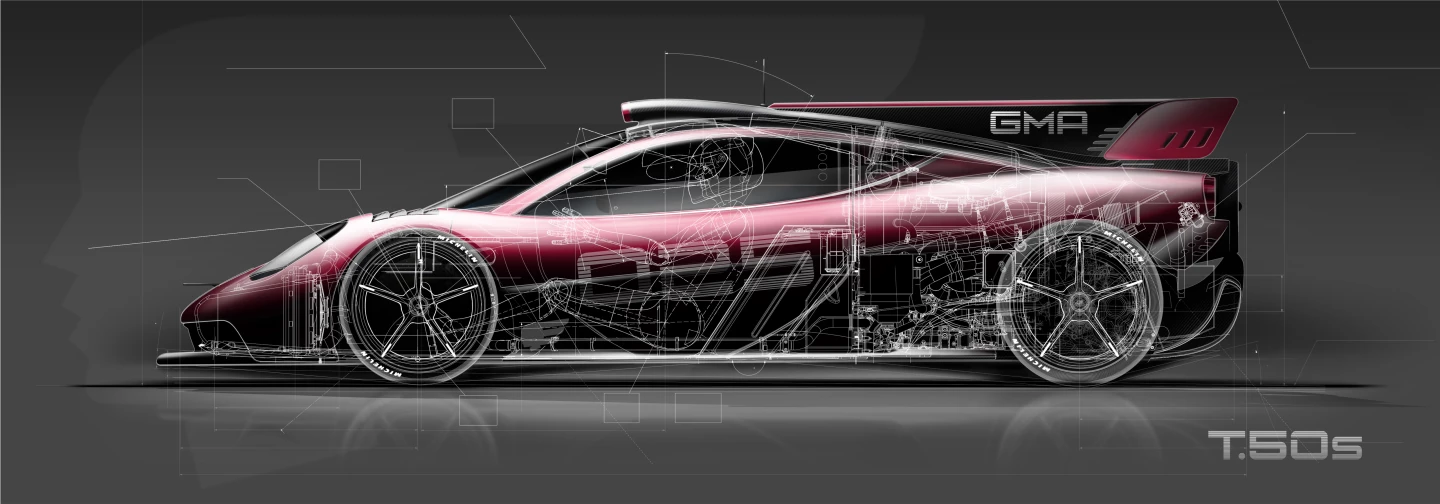Gordon Murray's T.50, with its record-smashing Cosworth V12 and fan-forced aerodynamics, is a truly fascinating car. And if you thought Murray, a storied veteran of Formula One, was going to build such a beast and not take it racing, you're nuts. There's a race version coming, and it's even nuttier.
The T.50, Murray tells us, sold out its entire allocation within 48 hours of its debut, but Murray is building something even more extreme for just 25 hardcore types that might actually drive them. For now, it's called the T.50s, and it adds power, drops weight and offers a savage level of downforce.
The removal of road gear, and a redesign of "hundreds of parts" contributes to a final weight of just 890 kg (1,962 lb), some 94 kg (207 lb) less than the T.50, which itself is an absolute featherweight for a supercar. The mid-mounted, 12,100-rpm Cosworth V12, "free from road-going legislation and maintenance considerations," in Murray's words, leaps from around 654 hp to somewhere around 720 with ram air boosted by a higher, periscope-style roof scoop.
You can of course forget about your air con and stereo. These, along with the carpets, glove box and even one of the passenger seats, have been turfed out. The other seat, the left one, remains in case you need a co-driver, and the driver's seat stays right in the middle of the cabin. The steering wheel becomes an F1-style rectangle, the seatbelts are replaced with harnesses, and the infotainment unit is replaced with a bunch of lap time, g-force and performance data, which can probably be described as infotainment for track jockeys.

The aeros on the T.50 are already legendary, but the road-going "fan car" gets a whopping 1.76-meter-wide (5.8-ft) delta wing on the back, as well as a new ground effect underbody aerofoil, redesigned front splitter, and adjustable diffusers. The fan itself, which operates in six different modes in the street car, has just one job on the T.50s, and so it operates in High Downforce mode at all times.
The result: 1,500 kg (3,307 lb) of downforce at speed, or 170 percent the weight of the car, meaning that it could drive upside down at 175 mph (282 km/h) if you were lucky enough to find a good length of upside-down road outside of an earthquake situation. Right way up, it'll stick like chewing gum in the ponytail of your third-grade crush, and in addition to savage cornering forces you can expect somewhere between 2 g and 3 g of deceleration when you apply six pistons' worth of Brembo to each of the carbon ceramic front brakes.
The suspension has been rejigged, not only to stiffen things up for track use and take account of that enormous downforce, but also to lower the ride height by 40 mm (1.6 in).

The T.50s won't go into production until the start of 2023, at a price of £3.1 million (US$4.12 million). Each of the 25 cars will look different and have a bespoke ergonomic setup tailored to the driver. Murray wants to organize his own series of racing events "to ensure the T.50s is driven regularly by owners."
As such, Murray and his team have been liaising with the SRO "regarding the potential for a GT1 sports club and race series for current supercars." Yes. Please. There are so many outrageous supercars out there right now running around making all sorts of claims that will never have to be backed up on the track. At some point, the flag has to drop and the bovine butt-porridge has to stop.

The T.50s seems like it might be a decent fit for the Le Mans hypercar class, and its feather-light weight and slavish attention to downforce – not to mention the credentials of the wizard behind it – would surely make it a fearsome competitor. Let's hope it comes to pass.
Source: Gordon Murray Motors





